Giáo trình Tiếng Anh chuyên ngành nhà hàng (Phần 1)
Unit 1
DESCRIBING JOBS AND WORKPLACE
Objectives
• Describing jobs and workplace
• Showing appropriate manner
Contents
• Language functions & skills
Introducing yourself and colleagues
Describing and explaining parts of restaurants
• Pronunciation Sentence stress
• Language study
Present simple, the verb be, there is/are
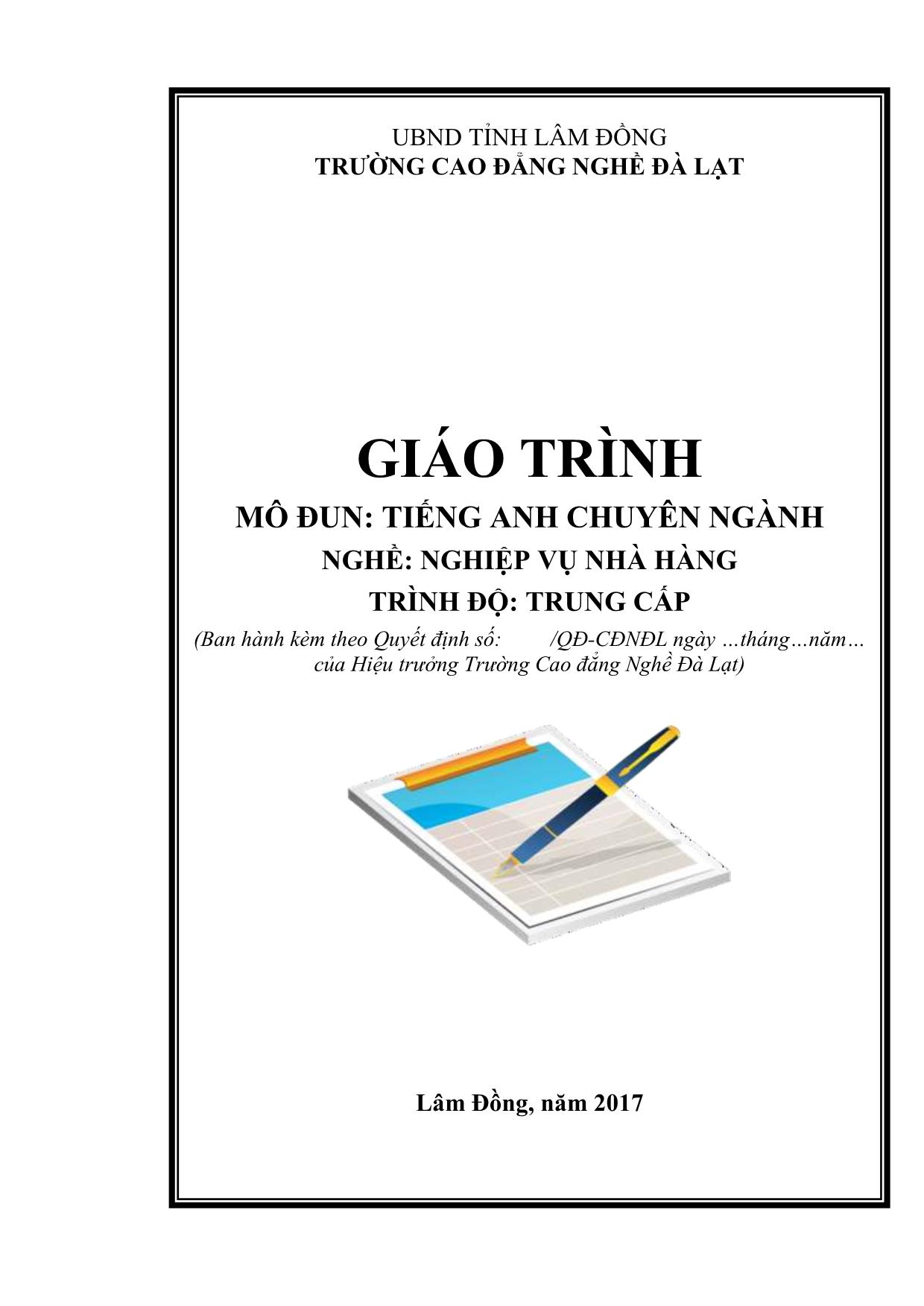
Trang 1
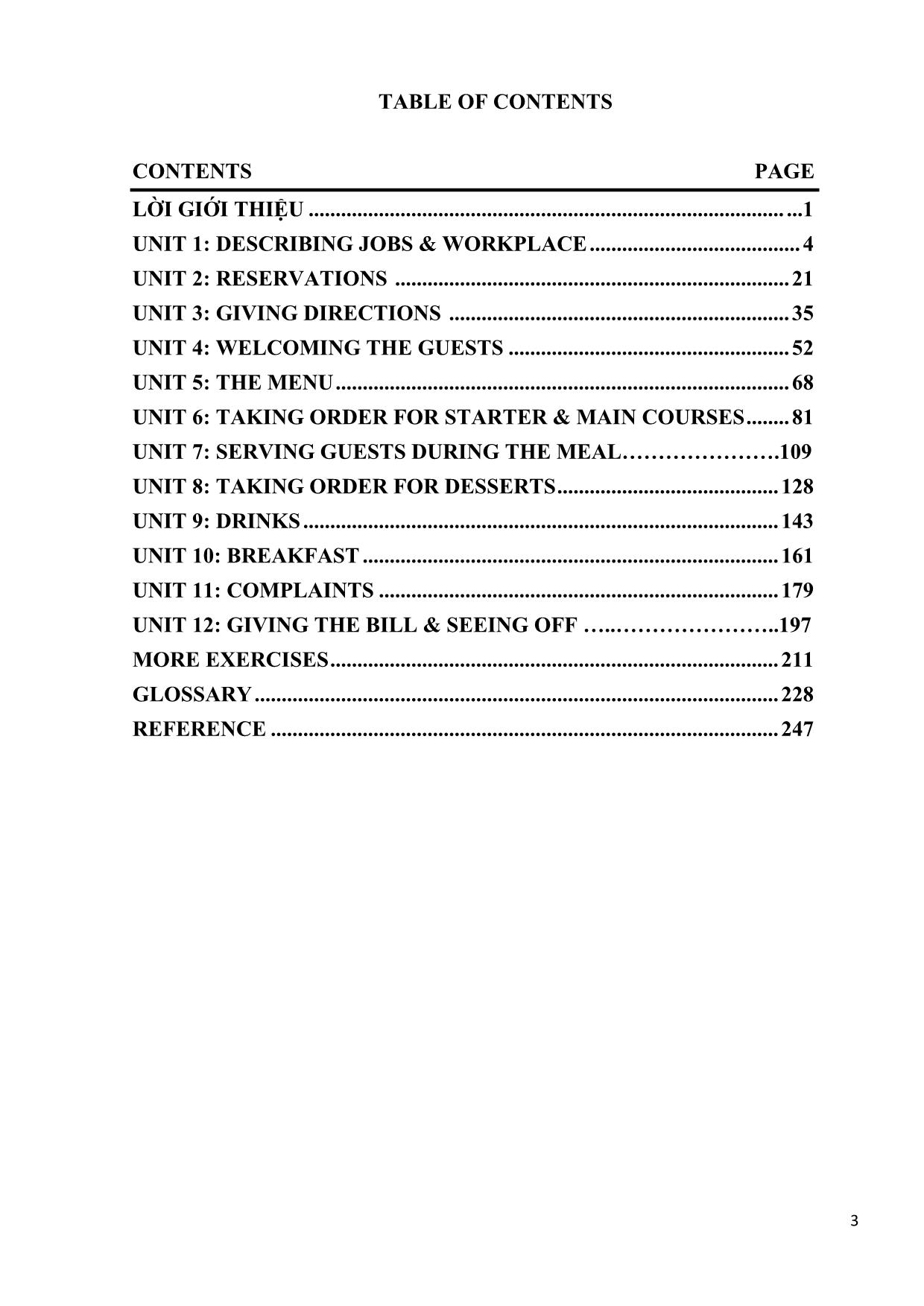
Trang 2
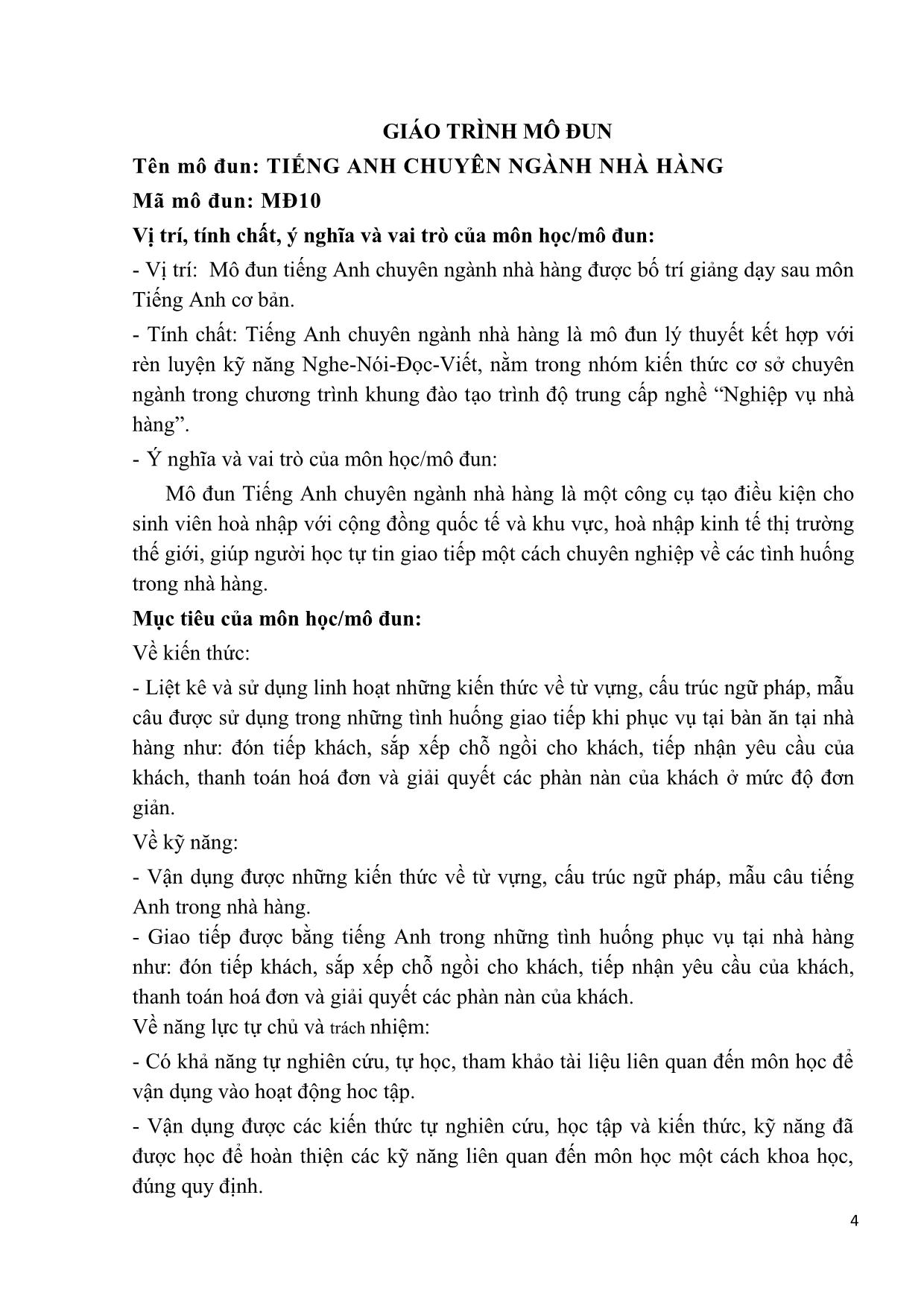
Trang 3
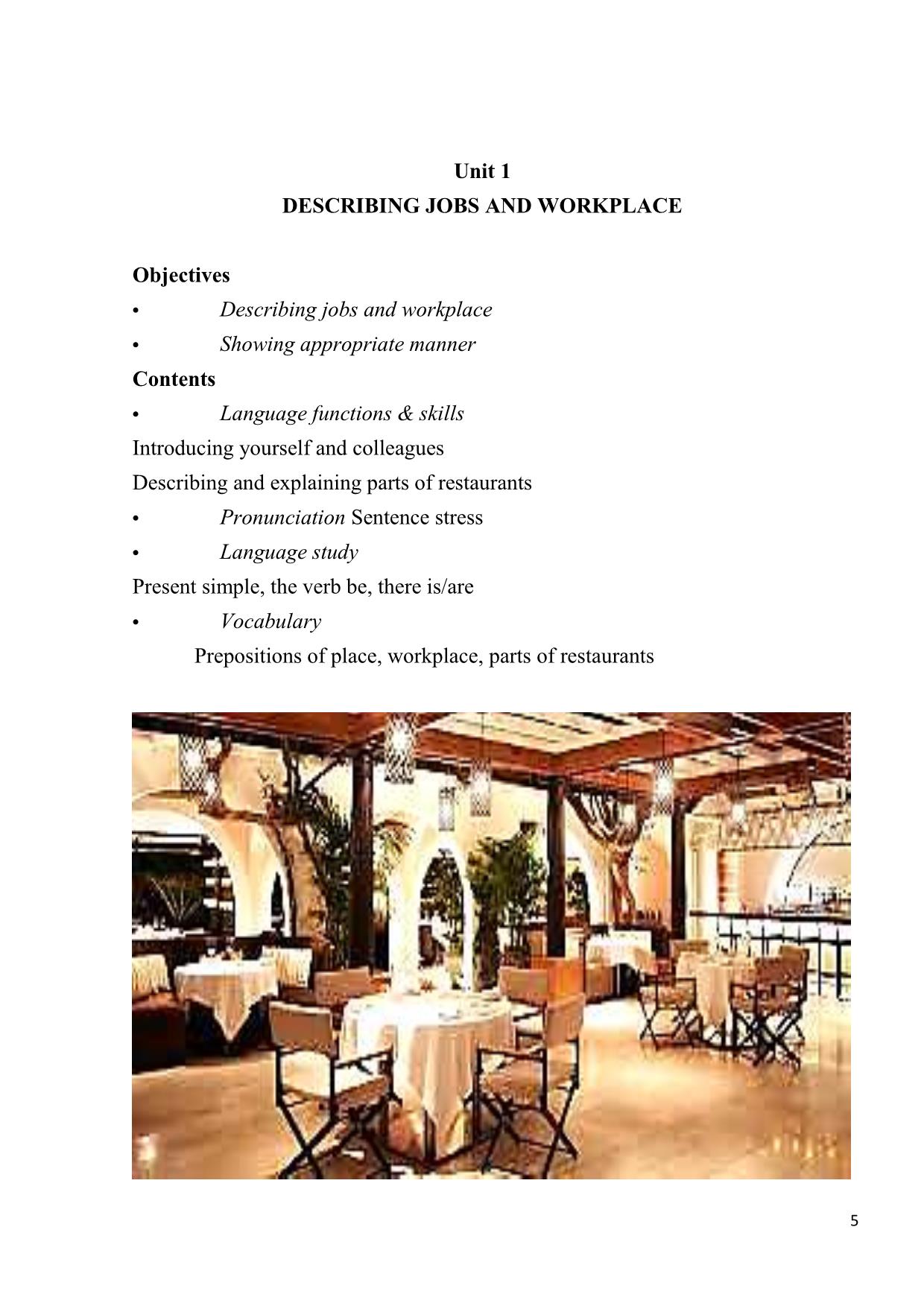
Trang 4
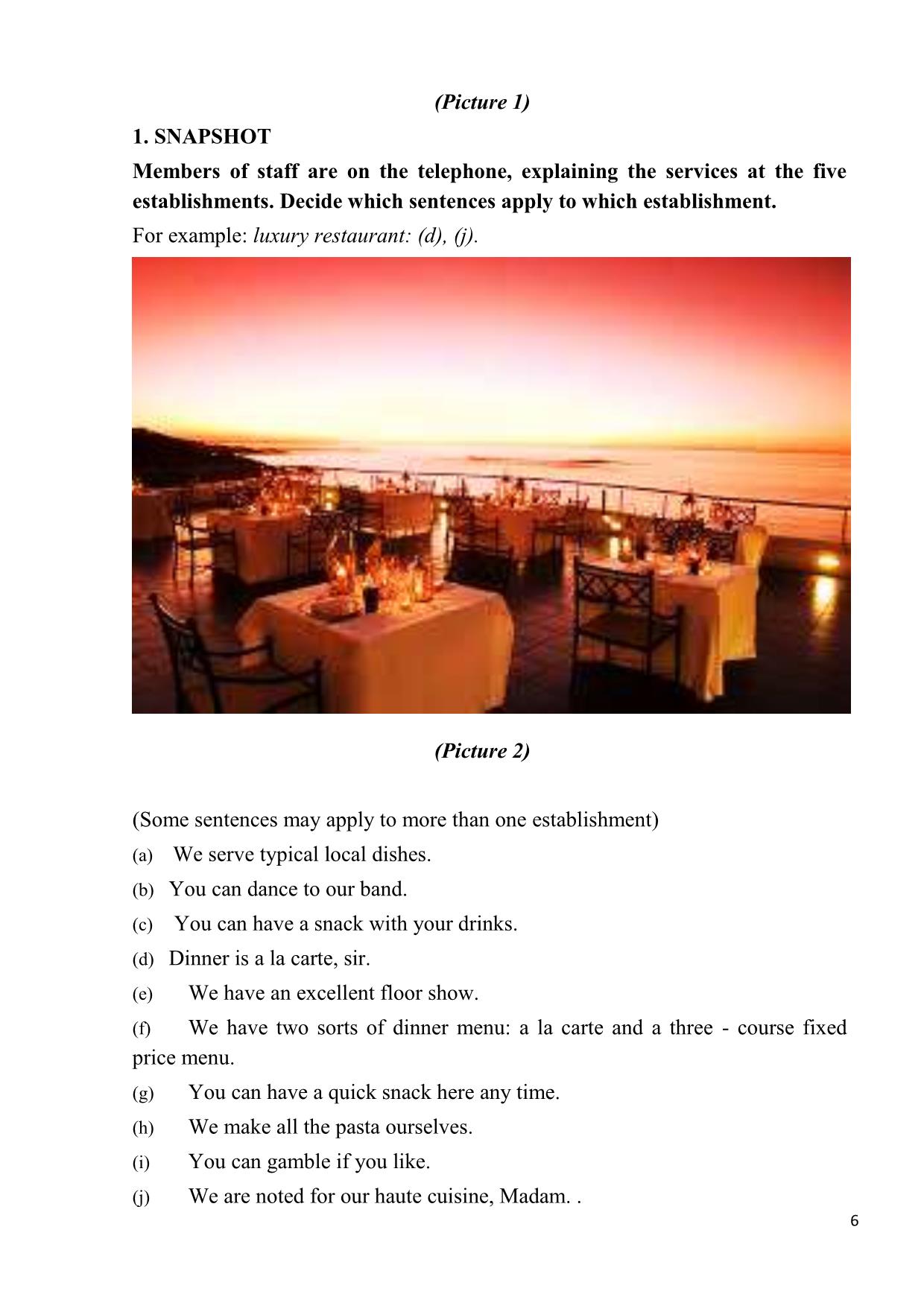
Trang 5
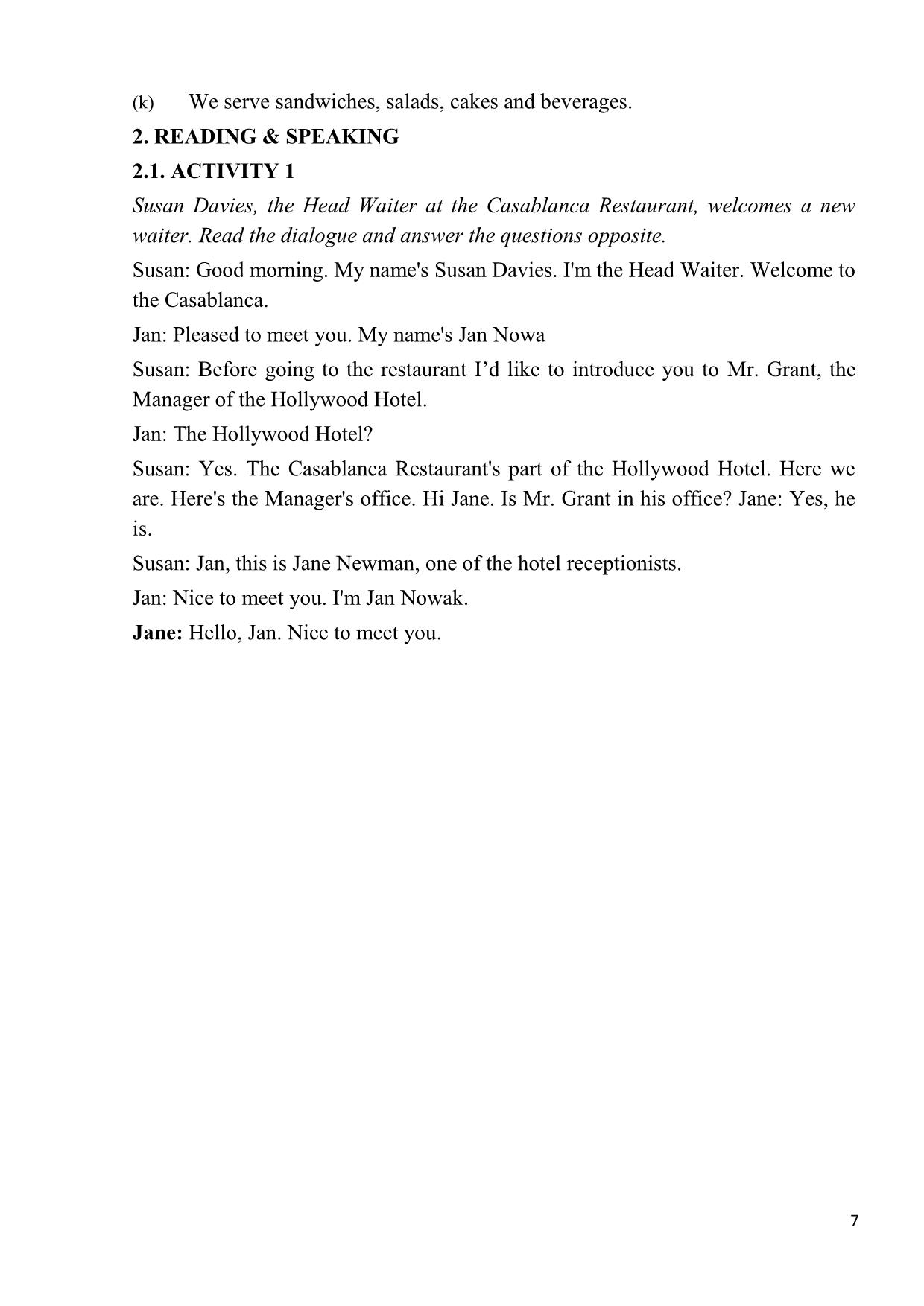
Trang 6
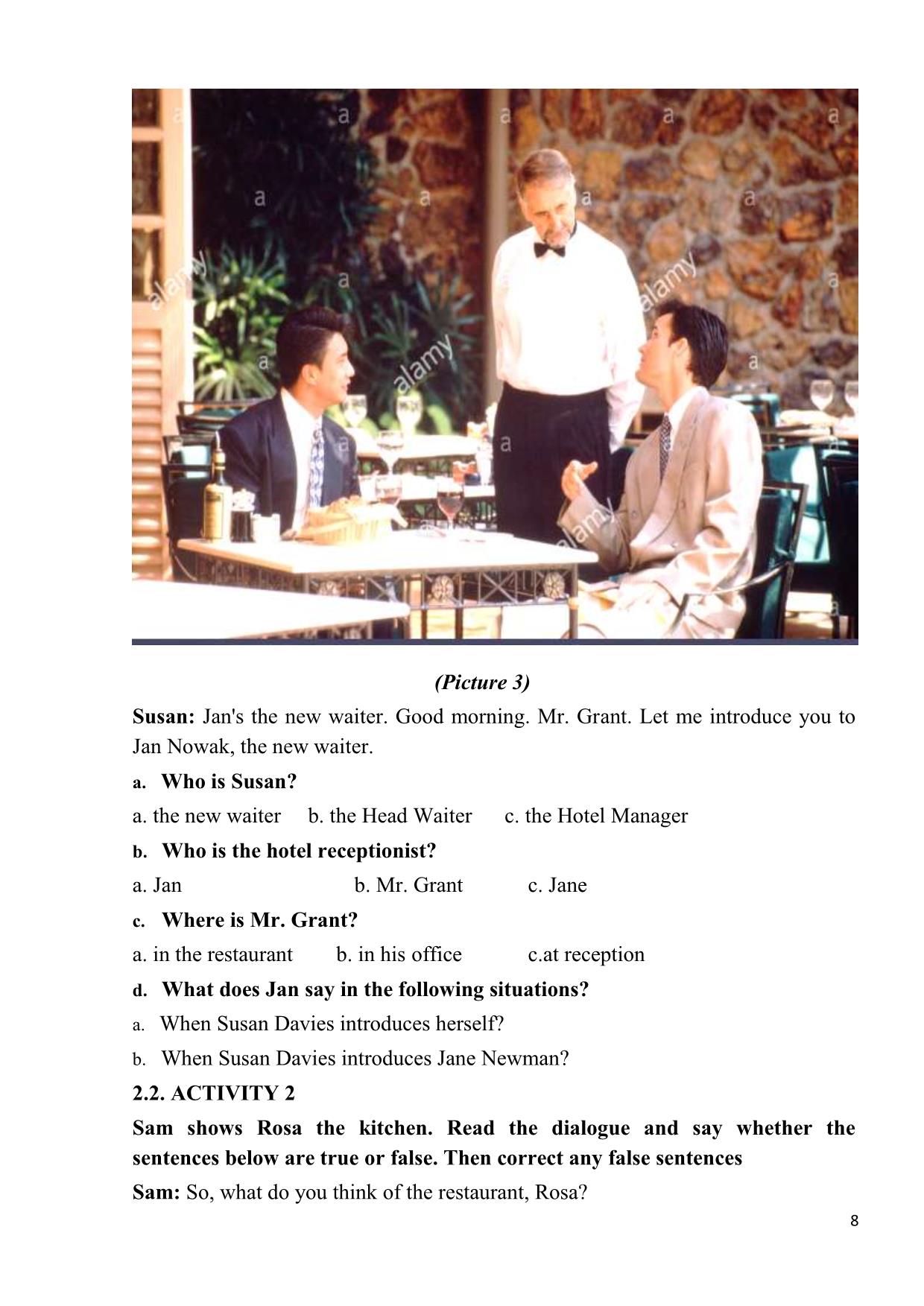
Trang 7
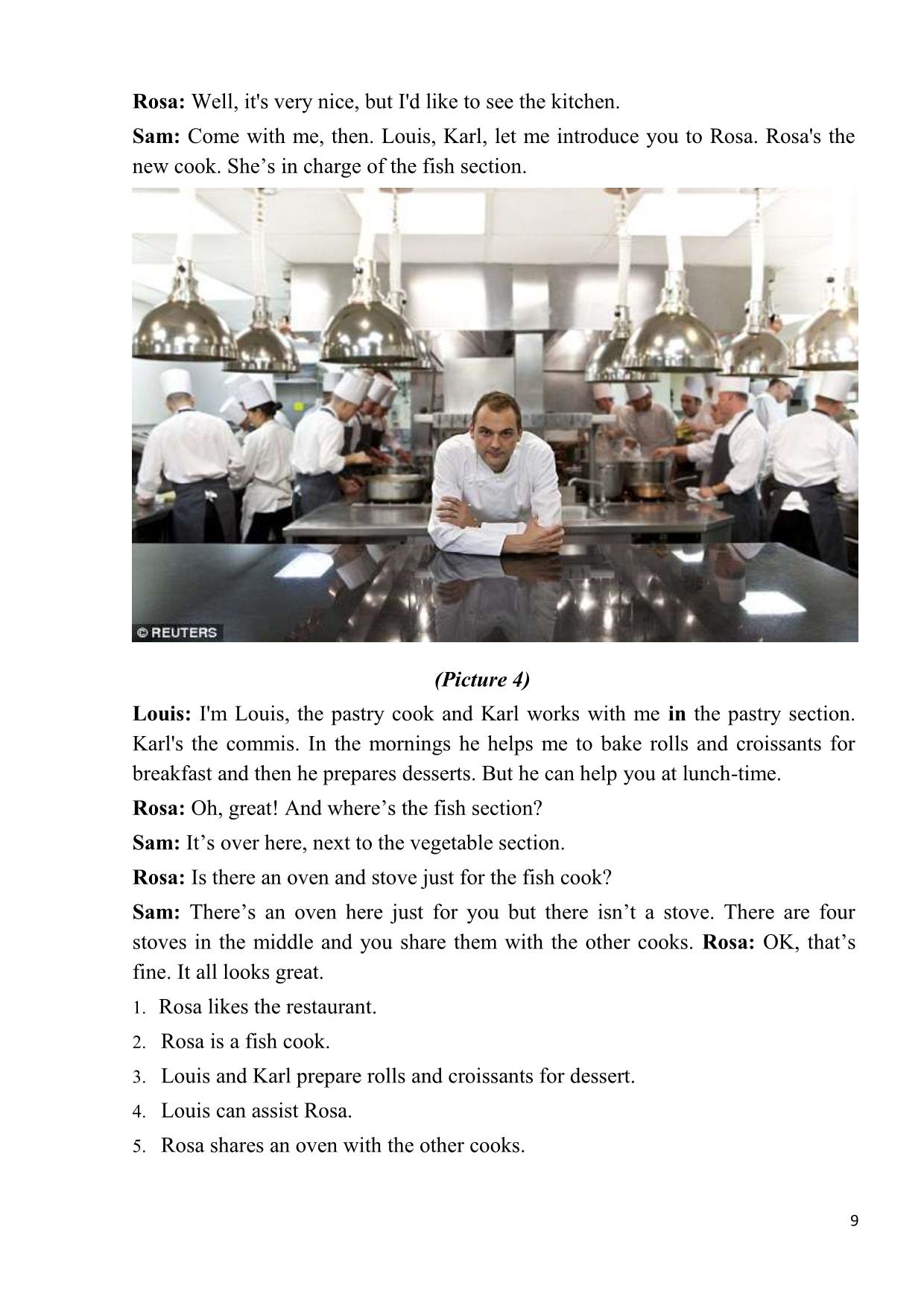
Trang 8

Trang 9
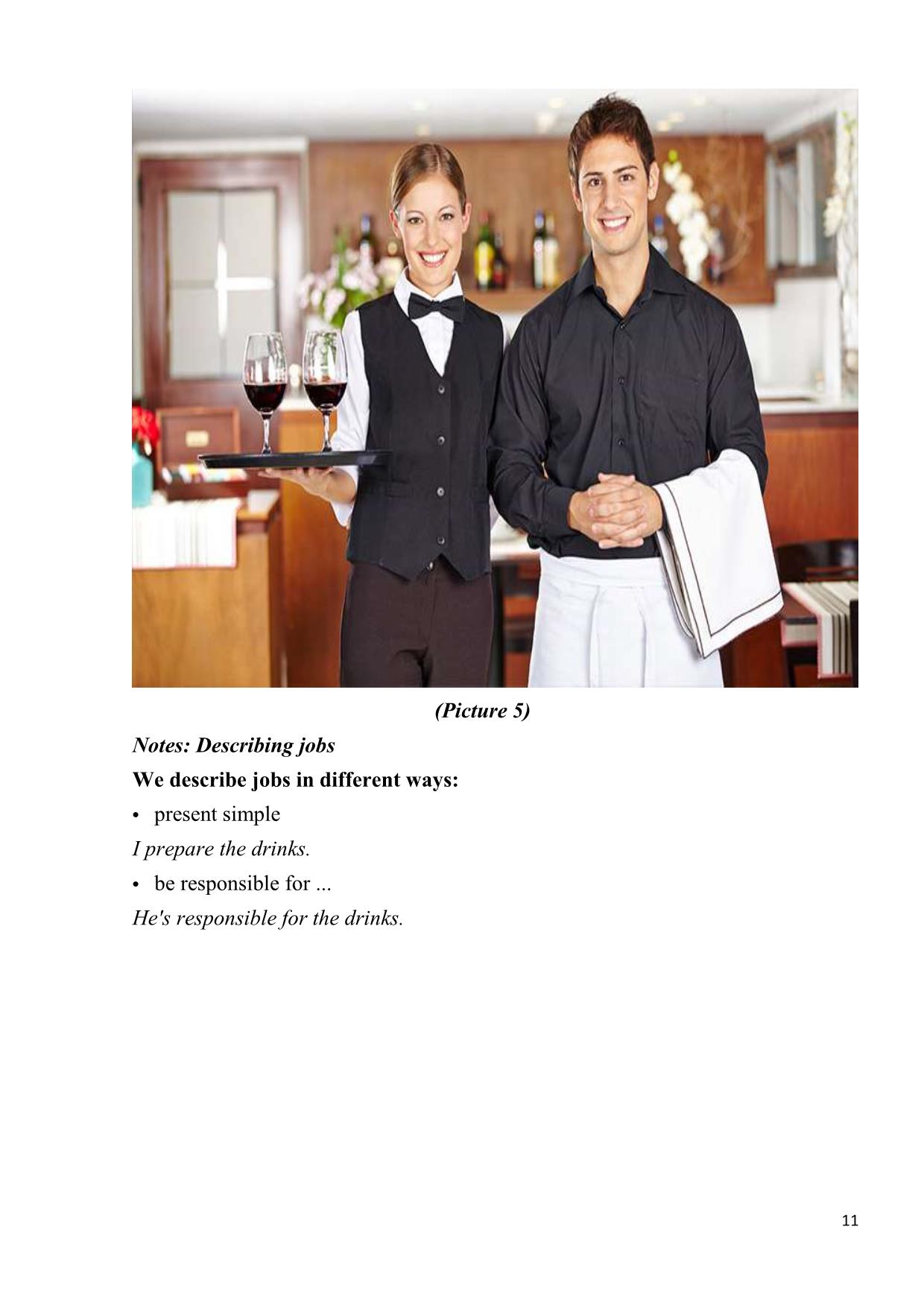
Trang 10
Tải về để xem bản đầy đủ
Bạn đang xem 10 trang mẫu của tài liệu "Giáo trình Tiếng Anh chuyên ngành nhà hàng (Phần 1)", để tải tài liệu gốc về máy hãy click vào nút Download ở trên
Tóm tắt nội dung tài liệu: Giáo trình Tiếng Anh chuyên ngành nhà hàng (Phần 1)
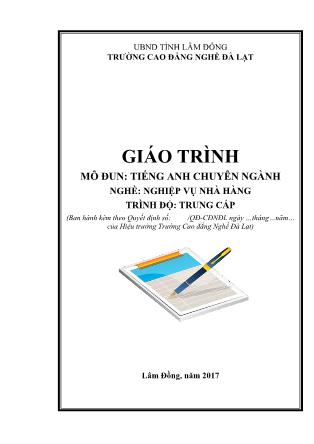
UBND TỈNH LÂM ĐỒNG TRƯỜNG CAO ĐẲNG NGHỀ ĐÀ LẠT GIÁO TRÌNH MÔ ĐUN: TIẾNG ANH CHUYÊN NGÀNH NGHỀ: NGHIỆP VỤ NHÀ HÀNG TRÌNH ĐỘ: TRUNG CẤP (Ban hành kèm theo Quyết định số: /QĐ-CĐNĐL ngày thángnăm của Hiệu trưởng Trường Cao đẳng Nghề Đà Lạt) Lâm Đồng, năm 2017 3 TABLE OF CONTENTS CONTENTS PAGE LỜI GIỚI THIỆU ........................................................................................ ...1 UNIT 1: DESCRIBING JOBS & WORKPLACE ....................................... 4 UNIT 2: RESERVATIONS ......................................................................... 21 UNIT 3: GIVING DIRECTIONS ............................................................... 35 UNIT 4: WELCOMING THE GUESTS .................................................... 52 UNIT 5: THE MENU .................................................................................... 68 UNIT 6: TAKING ORDER FOR STARTER & MAIN COURSES ........ 81 UNIT 7: SERVING GUESTS DURING THE MEAL.109 UNIT 8: TAKING ORDER FOR DESSERTS ......................................... 128 UNIT 9: DRINKS ........................................................................................ 143 UNIT 10: BREAKFAST ............................................................................. 161 UNIT 11: COMPLAINTS .......................................................................... 179 UNIT 12: GIVING THE BILL & SEEING OFF ....197 MORE EXERCISES ................................................................................... 211 GLOSSARY ................................................................................................. 228 REFERENCE .............................................................................................. 247 4 GIÁO TRÌNH MÔ ĐUN Tên mô đun: TIẾNG ANH CHUYÊN NGÀNH NHÀ HÀNG Mã mô đun: MĐ10 Vị trí, tính chất, ý nghĩa và vai trò của môn học/mô đun: - Vị trí: Mô đun tiếng Anh chuyên ngành nhà hàng được bố trí giảng dạy sau môn Tiếng Anh cơ bản. - Tính chất: Tiếng Anh chuyên ngành nhà hàng là mô đun lý thuyết kết hợp với rèn luyện kỹ năng Nghe-Nói-Đọc-Viết, nằm trong nhóm kiến thức cơ sở chuyên ngành trong chương trình khung đào tạo trình độ trung cấp nghề ―Nghiệp vụ nhà hàng‖. - Ý nghĩa và vai trò của môn học/mô đun: Mô đun Tiếng Anh chuyên ngành nhà hàng là một công cụ tạo điều kiện cho sinh viên hoà nhập với cộng đồng quốc tế và khu vực, hoà nhập kinh tế thị trường thế giới, giúp người học tự tin giao tiếp một cách chuyên nghiệp về các tình huống trong nhà hàng. Mục tiêu của môn học/mô đun: Về kiến thức: - Liệt kê và sử dụng linh hoạt những kiến thức về từ vựng, cấu trúc ngữ pháp, mẫu câu được sử dụng trong những tình huống giao tiếp khi phục vụ tại bàn ăn tại nhà hàng như: đón tiếp khách, sắp xếp chỗ ngồi cho khách, tiếp nhận yêu cầu của khách, thanh toán hoá đơn và giải quyết các phàn nàn của khách ở mức độ đơn giản. Về kỹ năng: - Vận dụng được những kiến thức về từ vựng, cấu trúc ngữ pháp, mẫu câu tiếng Anh trong nhà hàng. - Giao tiếp được bằng tiếng Anh trong những tình huống phục vụ tại nhà hàng như: đón tiếp khách, sắp xếp chỗ ngồi cho khách, tiếp nhận yêu cầu của khách, thanh toán hoá đơn và giải quyết các phàn nàn của khách. Về năng lực tự chủ và trách nhiệm: - Có khả năng tự nghiên cứu, tự học, tham khảo tài liệu liên quan đến môn học để vận dụng vào hoạt động hoc tập. - ận dụng được các kiến thức tự nghiên cứu, học tập và kiến thức, kỹ năng đ được học để hoàn thiện các kỹ năng liên quan đến môn học một cách khoa học, đúng quy định. 5 Unit 1 DESCRIBING JOBS AND WORKPLACE Objectives • Describing jobs and workplace • Showing appropriate manner Contents • Language functions & skills Introducing yourself and colleagues Describing and explaining parts of restaurants • Pronunciation Sentence stress • Language study Present simple, the verb be, there is/are • Vocabulary Prepositions of place, workplace, parts of restaurants 6 (Picture 1) 1. SNAPSHOT Members of staff are on the telephone, explaining the services at the five establishments. Decide which sentences apply to which establishment. For example: luxury restaurant: (d), (j). (Picture 2) (Some sentences may apply to more than one establishment) (a) We serve typical local dishes. (b) You can dance to our band. (c) You can have a snack with your drinks. (d) Dinner is a la carte, sir. (e) We have an excellent floor show. (f) We have two sorts of dinner menu: a la carte and a three - course fixed price menu. (g) You can have a quick snack here any time. (h) We make all the pasta ourselves. (i) You can gamble if you like. (j) We are noted for our haute cuisine, Madam. . 7 (k) We serve sandwiches, salads, cakes and beverages. 2. READING & SPEAKING 2.1. ACTIVITY 1 Susan Davies, the Head Waiter at the Casablanca Restaurant, welcomes a new waiter. Read the dialogue and answer the questions opposite. Susan: Good morning. My name's Susan Davies. I'm the Head Waiter. Welcome to the Casablanca. Jan: Pleased to meet you. My name's Jan Nowa Susan: Before going to the restaurant I‘d like to introduce you to Mr. Grant, the Manager of the Hollywood Hotel. Jan: The Hollywood Hotel? Susan: Yes. The Casablanca Restaurant's part of the Hollywood Hotel. Here we are. Here's the Manager's office. Hi Jane. Is Mr. Grant in his office? Jane: Yes, he is. Susan: Jan, this is Jane Newman, one of the hotel receptionists. Jan: Nice to meet you. I'm Jan Nowak. Jane: Hello, Jan. Nice to meet you. 8 (Picture 3) Susan: Jan's the new waiter. Good morning. Mr. Grant. Let me introduce you to Jan Nowak, the new waiter. a. Who is Susan? a. the new waiter b. the Head Waiter c. the Hotel Manager b. Who is the hotel receptionist? a. Jan b. Mr. Grant c. Jane c. Where is Mr. Grant? a. in the restaurant b. in his office c.at reception d. What does Jan sa ... lmon comes with (mash) ..potatoes and (melt) ............................. butter. - Would you like your beef (grill), (bake) or (fry)? - If you put (melt) ....................................... chocolate over the (slice)dessert. 6. VOCABULARY 6.1. Methods of cooking (a) in water or another liquid at 100C (b) in water or another liquid at a little less than 100 (c) in water or another liquid at 100, slowly and for a long time (d) in steam (e) in the oven, with very little or no far (e.g. bread) (f) in the oven, with fat (e.g. meat) (g) under (or over) direct heat (e.g. steak) (h) in fat or oil (i) in a little fat, for a short time Name: (i) to bake (ii) to boil (hi) to fry 101 (iv) to grill (Am.E= broil) (v) poach (vi) to roast (vii) to sauté (viii) to steam (ix) to stew (Picture 28) 102 (Picture 29) (Picture 30) 103 104 (Picture 31) 6.2. Work with a partner* Take turns to be A or B* (Picture 32) A. What can chefs grill? fry? B. They can grill salmon, lobster, liver, fry onions, mushrooms, cod, a. How can chefs cook salmon? Onions? B. They can bake, grill or poach salmon, boil, fry, or sauté onions, etc. 7. FOLLOW-UP 7.1. ACTIVITY 1 Lunch time at Junior's is a very busy time. Many hungry businessmen, workers and shoppers are eager to order their entrees. Can you take the orders of the gentleman in the suit and those two lovely ladies by the window and complete the following dialogues? 105 Dialogue 1 FISH AND CHICKEN FOR THE LADIES Take order entree: ......................................... Diner 1: I'll have the fried red snapper. (Picture 33) Ask about vegetables: ....................................... Diner X: What would you suggest? Morning glory, rice: ........................................ Diner 1: I believe you. I'll have that and please make sure it's not too spicy. Repeat order diner 1: ....................................... Take order diner 2: ......................................... Diner 2: I'll have roast chicken and French fries, please. Ask about salad: ......................................... 106 (Picture 34) Diner 2: Have you got coleslaw? You don't have: ......................................... Diner 2: Then bring me a lettuce and tomato salad. 107 (Picture 35) Ask about dressing: .............................................. Diner 2: What dressings have you got? Mayonnaise ......................................... Diner 2: With Italian dressing, please. Repeat order diner 2: ............................................ Dialogue 2 A STEAK FOR THE GENTLEMAN IN THE SUIT Take order entree: ....................................................... Diner: I think I‘ll try the porter house steak. How steak: ......................................................... (Picture 36) Diner: Medium-rare, please. Vegetables: .............................................. . ......... Diner: Yes, I'll have ... green beans and baked potatoes. Salad: ......................................................... Diner: No, thank you. 108 Repeat order: ......................................................... 7.2. Expressions for taking order for main course Are you ready to order your entree, sir? Would you like to order now, miss? Would you like a salad with your dinner, miss? What vegetables would you like, madam? Would you like some vegetables with it, sir? Tomato and cucumber salad with French dressing Yes, I'll have the lamb chops with mint sauce. 8. SPEAKING Work with a partner A should read the information below, then practice with your partner: (a) A, You are a waiter/waitress. (b) B, a customer, will ask you questions about Ratatouille. Ratatouille: a sort of vegetable stew. 109 (Picture 37) Main ingredients: tomatoes, aborigines, green peppers, courgettes. Additional ingredients: oil, butter, garlic. Preparation: slice main ingredients. Method of cooking: sauté and then stew slowly in the oven. Accompaniment: serve with boiled potatoes or rice. (a) A, You are a waiter/waitress. (b) B, a customer, will ask you questions about Tortilla Here is the information you need: Tortilla: a sort of omelet (Picture 38) Main ingredients: eggs and potatoes Additional ingredients: onion (just a little) Preparation: slice potatoes, chop onion Method of cooking: fry in oil. Accompaniment: serve with a green salad. A: Customer What's....? 110 What's this dish here? Can you tell me about this? Is there a lot of onion in it? How much onion is there in it? Does it contain any garlic? Is there any flour in it? What's it served with? What does it come with? Is there anything to go with it? Does it come with a salad? 9. USEFUL WORDS AND EXPRESSIONS Talking about Different Dishes: What is this cold hors d'oeuvre that's on the menu? What is in this spicy noodles salad? What is this snakehead with dressing? What are these spare ribs in pineapple? Describing Dishes: Ingredients & Preparation It's a minced pork and bean curd soup. It's a spicy fish soup. It's dried squid. Fried/roast/grilled/... chicken. It's smoked ham/fish/salmon/mackerel... It's raw fish served with a mustard sauce and fresh vegetables Talking about Side Dishes The dish is served with pickled vegetables. It is served with a sweet-and-sour sauce. They are served with a hot and sweet sauce. It comes with a hot-and-sour sauce. Taking an Order for Steaks & Meat Dishes How would you like your steak (done), sir? Well-done, please. 111 Medium, please. Medium-rare, please. Rare, please. What vegetables would you like to go with it, sir? Would you like boiled potatoes or French fries, madam? Will you have rice with your meal, miss? Cauliflower and mashed potatoes, please. French fries, please. Fried, Boiled or Stewed Vegetables Accompaniments French dressing, mayonnaise, (tomato, etc.) sauce Countable, plural: cromons, dumplings Pieces of food (countable) small/large pieces of meat, a slice of chicken, strips of ham; a chop, a cutlet, a fillet, a steak Adjectives describing foods or dishes cold, hot, raw, cooked, spicy, salty, sour, rich, heavy, light, creamy; clear soup, thick soup Adjectives describing ingredients fresh, smoked, tinned (Am.E = canned)- mixed; herd-boiled eggs Verbs describing ways of cutting chop,, fillet, grate- mash, mince, shred, slice Verbs describing ways of cooking In water or other liquids: boil, braise, poach, stew In steam: steam. In fat or oil: fry, sautee In dry heat: bake, grill (Am.E = broil), roast Compound nouns wine sauce, lemon dressing, rice stuffing Verbs with-ed for describing preparation and cooking sliced mushrooms, stewed beef The passive for explaining dishes The cod is poached in milk. The tomatoes are scuffed with rice. Expressions of quantity For 'uncountable' ingredients: no, very little, (just) a little, some, quite a lot of, a 112 lot of butter For (countable' ingredients: no, very few, (just) a few, some, quite a lot of, a lot of olives Phrases describing the composition of dishes - It's a sort of pie. It's like an omelet. It contains flour. It's made of fish and vegetables. It consists of fish and vegetables. It's cooked in oil. It‘s filled with cream. It's stuffed with rice. It's flavored with garlic. It's garnished with tomatoes. It's served with potatoes/on (a bed of) rice. Questions about dishes Does it contain any garlic? What's it served with? Does it come with a salad? 113 Unit 7 SERVING GUESTS DURING THE MEAL Objectives • Asking, and understanding guests' opinions and wishes • Suggesting alternatives • Showing appropriate manner Contents • Language functions & skills Asking, and understanding guests' opinions and wishes, Asking about guests' extra requests Suggesting alternatives Asking about the food after the meal • Language study Countable and uncountable • Vocabulary Adjectives for praising and criticizing food Kinds of restaurant services 114 (Picture 1) 1. SNAPSHOT Match the words in column 1 with those in column 2: Column 1 1. May I serve 2. This dish 3. May I move your plate.. 4. Have you finished 5. Would you 6. How is 7. Are you enjoying 8. May I clean (clear) 9. This is our last service coffee 10. We are taking the orders for food (drinks) 11. This food is best eaten while hot make useful expressions 115 (Picture 2) 116 Column 2 a. it to you now? b. is very hot. Please be careful. c. to the side? d. your meal, sir? e. like some tea? f. your meal? g. your meal, sir? h. the table, sir? i. Would you like some more? j. Will there be anything else? k. Please enjoy your meal. 2. READING: 2.1. ACTIVITY 1: (Scene: Paul and Wilma are having their main course at Junior s Kitchen and the waitress checks to see whether the diners would like anything else). (Picture 3) 117 Wilma: Excuse me, miss ..? Waitress: Yes, madam ...? Wilma: Could I have some more of this fish bouillon? (Picture 4) Waitress: I'll check for you, madam. Just a moment, please. Wilma: Would you like some more French fries, sir? (Picture 5) Paul: Oh, yes, please. Here you are, sir. Paul: Thank you Waitress: I'm sorry, madam, but there isn‘t any fish bouillon left. Could I get you anything else? Wilma: Well, could I have some bread, please? Waitress: Certainly, madam. Would you like to have it toasted? 118 (Picture 6) Wilma: Yes, please Waitress: Just a moment, please Waitress: Here you are, madam. Wilma: Thanks Waitress: Could I get you another beer, sir? Paul: No, I'm fine, thanks.. 2.2. ACTIVITY 2: Work in group, one acts as waiter, the others act as cus- tomers. The waiter serve the customers during their meal using these expressions (Picture 7) 119 1. Some more ice? 1. Would you like another beer? 2. Would you like some more bouillon? 3. Would you care for some more rice? 4. Could I get you anything else? 5. I‘m afraid the kitchen is already closed, sir. 6. Certainly. Black Label. And some more ice. sir? 7. Yes, of course. I‘ll check for you. 9. Could I get you some more sauce? 10. I'm sorry, but there isn't any roast chicken left. 2.3. ACTIVITY 3: Put another or some more in these sentences. Then practise saying them. Add local dishes for further practice. 1. Would you like ............. potatoes? (Picture 8) 2. bottle of wine? (Picture 9) 120 3. finger bowl? (Picture 10) 4. cream? (Picture 11) 5. pot of coffee? (Picture 12 121 (a) delicious; excellent (b) tasty (c) juicy (d) fresh revolting, terrible (e) tender (meat) (f) sweet (fruit) 1. sour 2. dry 3. awful, horrible, ghastly, 4. sale, old, off 5. tasteless 6. tough 3. VOCABULARY 3.1. ACTIVITY 1 A customer who is enjoying a dish could use the words in column. Find words in column 2 which mean approximately the opposite. For example: (a) - 3. 3.2. ACTIVITY 2 Criticizing food: awful, horrible, ghastly, revolting, terrible, tasteless, dry, stale, old, off, tough, sour, bitter; too hot/sweet, not hot/sweet enough; undercooked, underdone, overcooked, overdone (Picture 13) 122 Fill in the blank with correct word 1. This beef is too ....................... I can't chew it. 2. I think the vegetables are not fresh. They are .................. 3. This food must have been cooked for too long. It‘s......... 4. The milk is too ............................ I can‘t drink it 4. USEFUL WORDS AND EXPRESSIONS Words for describing different kinds of service Questions to ask during a meal. Is everything all right, Sir/Madam? Would you like anything/some ketchup/a roll to go with your . Would you like some more wine/another roll? Responding to requests Certainly, Sir/Madam. I'll bring you some. . ./a . . . straightaway. I'll get you some. . . /a ... straightaway. I'm very sorry, Sir/Madam. We have none./We don‘t have any./ We don't have that./We have no... Perhaps you'd like some.../a ... instead? Customers' wishes No, thanks. I won‘t have any. I'd better not. I don‘t want much/many; Not too much/many. (Just) a little/a few; (just) a couple; a tiny slice/portion/ helping; go easy with the..., lots, a lot; plenty, a large/good-sized helping. Guerdons service (Am.E = French service) (Picture 14) 123 Silver service (Am.E = Russian service) (Picture 15) (Picture 16) Plate service (Am.E = American service) (Picture 17) Carvery service (Picture 18) 124 cafeteria/counter service (Picture 19) Equipment a trolley (Picture 20) 125 a service counter (Picture 21) a sideboard (Picture 22) 126 a side table (Picture 23) a hotplate (Picture 24) (Picture 25) a silver flat (Am.E = planer) (Picture 26) 127 a vegetable/entree dish (Picture 27) a sauce boat (Picture 28) a soup tureen (Picture 29) 128 Procedures to carve (Picture 30) (Picture 31) to flambé (Picture 32) to fillet (Picture 33) 129 Praising food delicious, excellent, out of this world, tasty, juicy, fresh, a tender steak, sweet cherries (Picture 34- I'm enjoying this food) Criticizing food awful, horrible, ghastly, revolting, terrible, tasteless, dry, stale, old, off, tough sour, bitter; too hot/sweet, not hot/sweet enough; undercooked, underdone; overcooked, overdone Accompaniments Ketchup (Picture 35) 130 Mustard (Picture 36) Gravy (Picture 37) horseradish sauce (Picture 38) 131 Mayonnaise (Picture 39) salad dressing (Picture 40) sauce tartar cream (Picture 41) 132 croutons (Plural) (Picture 42) crackers (plural) (Picture 43)
File đính kèm:
 giao_trinh_tieng_anh_chuyen_nganh_nha_hang_phan_1.pdf
giao_trinh_tieng_anh_chuyen_nganh_nha_hang_phan_1.pdf

